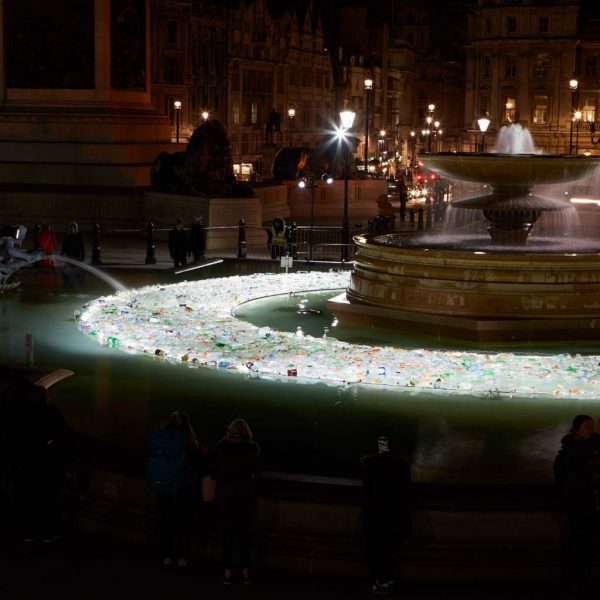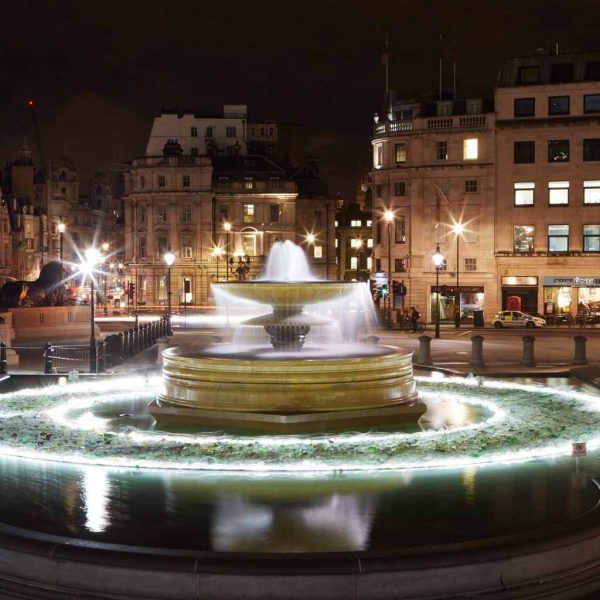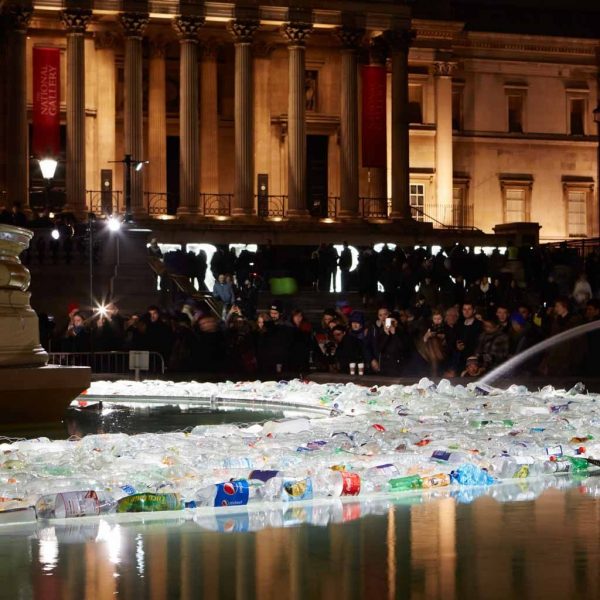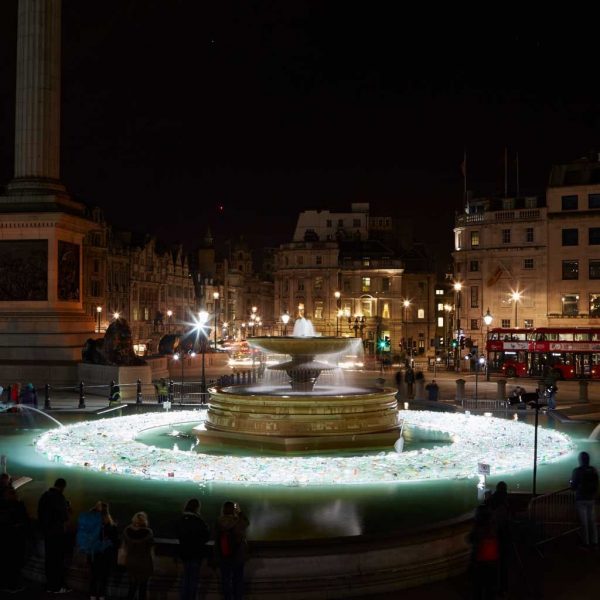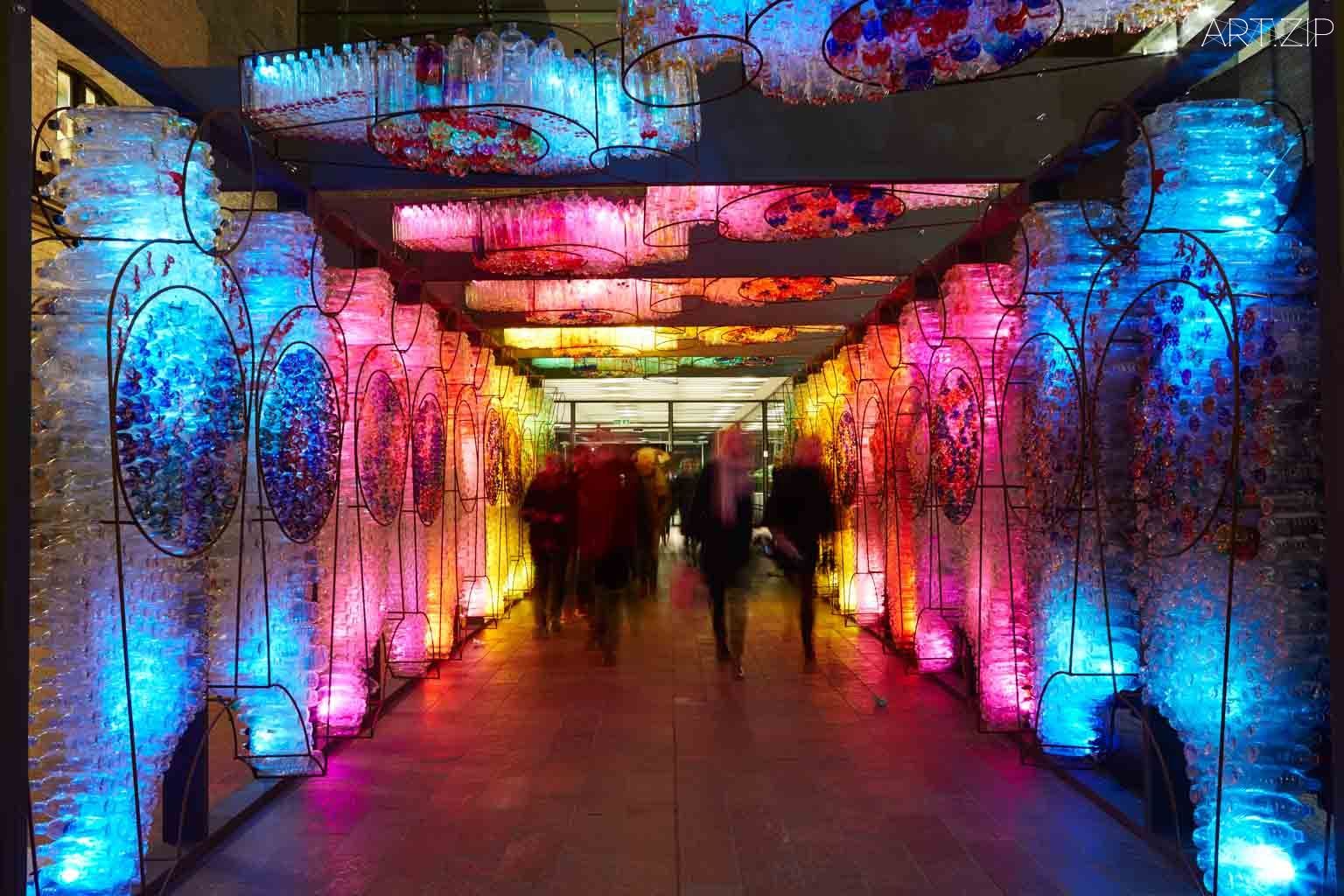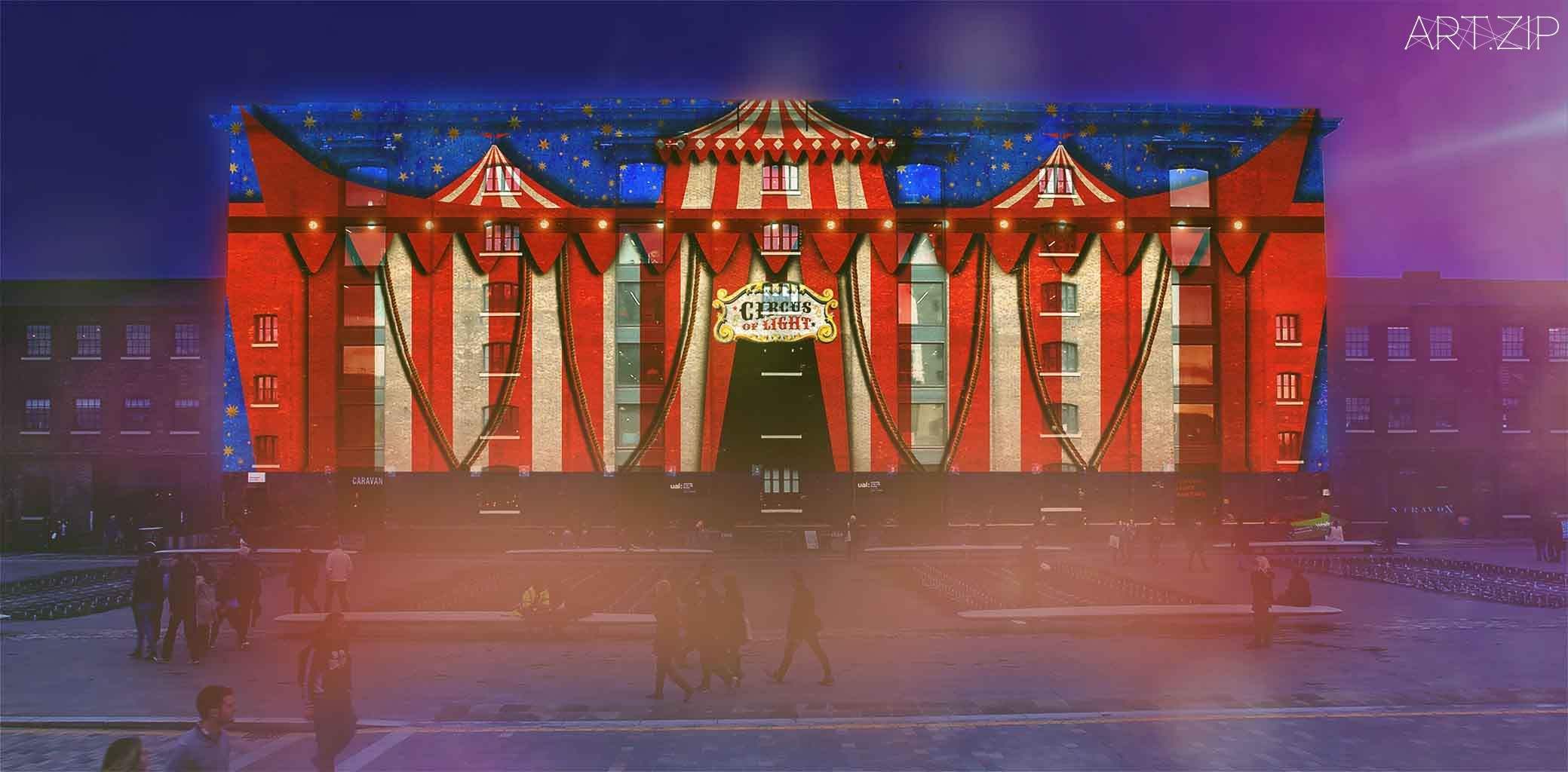
Interview and Text by 撰文 X Sophie Guo 郭笑菲
IMAGES COURTESY OF 圖片提供 X ARTICHOKE TRUST
In a hope to revitalise the cities in the midst of the darkness of winter, Artichoke Trust made an epic return to Durham with its four-day light festival Lumiere in November, followed by another turn in central London two months after. Dotted around 30 different locations yet highly accessible by walk between the spots, the site-specific light projects in London attracted an estimated one million visitors. There were fluorescent giant whales swimming above Piccadilly, phone boxes in Mayfair transforming into goldfish bowls and light graffiti ‘paint’ spraying around at King’s Cross. These eccentric light installations were the elements that transformed the city landscape into a real-life dream space.
Building the live experience is central to what Helen Marriage, the Founder of the Artichoke, thinks about when she plans the project. Lumiere suggests an alternative way for people to sense the city, through a different interpersonal relationship as opposed to the virtual kind that is highly common in the contemporary digital age. The festival attracted thousands of people who left their routine journeys, plotting out adventures into the once familiar, now strange, city. This is what Marriage had to say about the challenges that she faced in her curatorial process and the extraordinary change that the festival brought to the city and to its residents.
為了復蘇在冬日的黑寂中沈睡的都市,洋薊基金會(Artichoke Trust)於2015年11月在杜倫舉辦了為期四天的“盧米埃”燈光節,兩個月後又把它帶到了倫敦市中心。倫敦燈光節吸引了將近一百萬觀眾前往觀賞。這些與城市空間及建築貼合緊密的燈光裝置星星點點散布在30個不同的地方,但點與點間步行便可到達。熒熒發亮的“巨鯨”遨遊在皮卡迪利街上方;梅費爾街頭的電話亭變作了“金魚缸”;以燈光為色的塗鴉顏料揮灑在國王十字的中央…城市原本的風貌因這些別具一格的燈光裝置而化作現實生活中的夢幻世界。
洋薊製作公司創始人兼燈光節策劃人海倫·麥里奇(Helen Marriage)認為“如何創造現場體驗”是燈光節所要考慮的核心問題。燈光節將人們吸引到了街上,讓他們在實實在在的共處中體驗這個城市。這種真實的相處方式正好與在數碼時代的當下人們之間習慣養成的虛擬關係相悖 。燈光節誘使了成百上千的群眾放棄他們慣常的行走路線,在曾經熟悉而如今陌生的城市間展開探險。我們來看看麥里奇在她的策劃過程中都遇到了哪些挑戰,燈光節最終又為城市與居民的日常生活體驗帶來了怎樣的巨大變化。
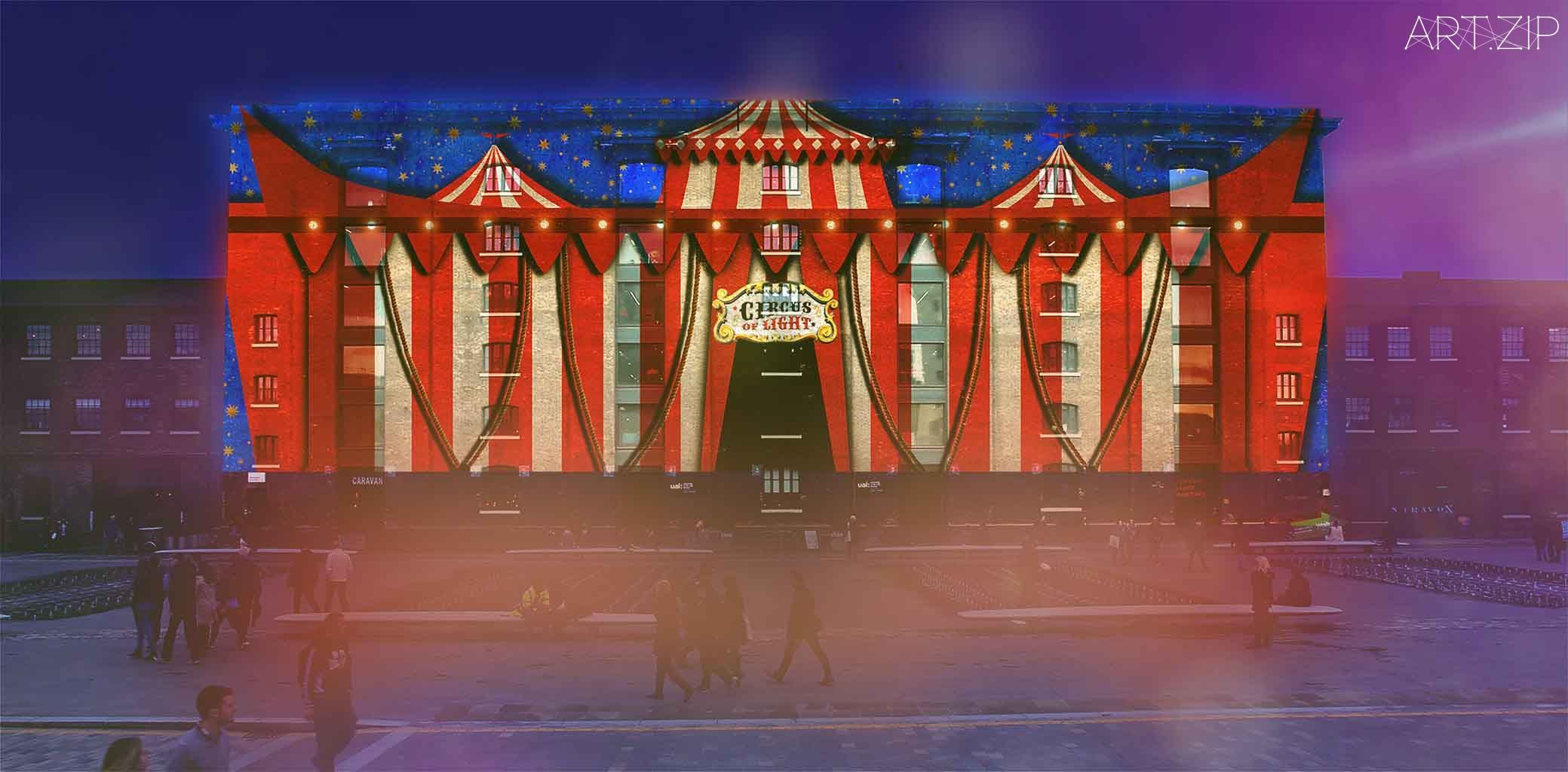
Circus of Light, Ocubo.com, Portugal 2013
ART.ZIP: We were so impressed by the Lumiere. According to reports from the government and the Guardian, the festival transformed the city. Was this public art programme a collaboration with the government in the first place?
HM: Sort of but not quite like that. The Mayor of London office commissioned us to do a study of whether Lumiere in London could work in the same way as it was in North England, where we go every two years in Durham. We wrote a study for them, and also for several business districts that have the interest in animating West-end districts in the dead month of January when it is quiet, end of Christmas, and everybody is feeling sad. They sponsored a lot of money and everybody was very excited about that possibility. However, it turned out that they gave us 20% of the budget and then we raised the rest of the money from the business districts or from landowners from the central area. For these organisations, having a big animated event is very important in terms of attracting people into the city and presenting London as a vibrant world.
ART.ZIP: 盧米埃燈光節給人們留下了非常深刻的印象,政府與《衛報》報道說它為城市帶來了巨大的轉變,那麽這個公共藝術項目是從與政府的合作開始的嗎?
HM: 在某種程度上算是吧,但不完全是。倫敦市長辦公室讓我們出一個報告說明,如果在倫敦做燈光節,是否能與我們在英格蘭北部城市杜倫舉辦的兩年一度的燈光節做出一樣的效果。我們為他們寫了考察報告,同時也聯繫了幾個商業區,他們希望我們能在聖誕節結束後、人們容易感到寥落感傷的一月去讓西邊商業區重新煥發生機。政府給了我們不少贊助,但只達到預算的百分之二十。我們從商業區負責人與中心地區的土地持有人那兒籌得了余下的款項,因為對於他們來說舉辦這樣一個充滿活力的盛會能夠吸引人們來倫敦,更能展現倫敦的生機與繁榮。
ART.ZIP: In order for the light to adapt perfectly to the architecture and urban space, what did you need to take into consideration when you curated it? Is there any subtle digital programming set in beforehand?
HM: Depends on the piece. When I curated the programme, I tried to choose the place that the artists felt suit their work best, but it also has to work in terms of particular buildings that we animate for the sponsor, for the government, or even to help with the crowd management. When you have so many people in the streets, you have to be careful not to create a bottleneck or a jam. If you put something very small at the little corner, so many people try to get to see it and this will cause problem.
The curation of Lumiere is about the following aspects:
- Quality of the artwork and how it reveals a new side to the urban architecture and the experience.
- Crowd management and the logistics of making the event work.
- Serving the purposes of the sponsor or the stakeholder who has asked us to work with that particular buildings.
When you do a programme in the public it is multi-layered in terms of what you are thinking about; you’re always trying to flex what you’re talking to make it serve all these different purposes. What is most important, is the audience’s experience—none of these three people, government or sponsors or department of transport, was really concerned what it feel like to be an audience member in front of these works. One of the most important aspects of our job is to try and predict what the emotional reaction of the audience will have.
ART.ZIP: 要讓燈光裝置跟城市建築與空間緊密貼合,您策劃的時候需要考慮到什麽?是否需要做詳細的編程設計呢?
HM: 這要看具體作品而論。我策劃整個項目的時候會幫藝術家找最適合他們作品呈現的地方,但也要考慮到贊助商跟政府的意願、考慮他們希望我們去“激活”哪幾幢大樓,甚至我們還要考慮到人群的管理與分流。燈光節期間會有大量人群湧上街頭,你必須要考慮到如何避免制造交通瓶頸與堵塞。比方說你若選擇在一個小角落放小作品,人們就只好圍上去看,這樣就會產生麻煩。
我的策劃主要考慮的是這幾點:
- 作品的質量以及它將如何賦予城市建築新的生命力、如何為觀眾創造新的觀感與體驗。
- 人群管理與分流,這是能讓燈光節順利運行的必要條件。
- 達成贊助人希望我們就特定建築制作燈光裝置的意願。
所以當你策劃公共項目的時候,所需要考慮的問題是多方面的。你得試著去柔韌處理以滿足這些不同的需求。比這些更重要的是觀眾體驗,但無論是政府還是贊助人抑或交通協調方都不會認真考慮作為觀眾站在燈光作品前會是什麽感受。而我們工作中最重要的一點就是了解觀眾觀看作品時會有一個怎樣的情緒反應。
ART.ZIP: The psychological affect that the Lumiere had on the audience is very interesting as it made the people so happy and calm in this busy urban environment. Did you study the psychological effect of the geographical environment to the emotion and behaviour of individuals before organising this event?
HM: I don’t study anything particularly-it is just an instinct. I’ve been doing it for really long time and I can feel that if I have one skill, it’s being able to feel what it will be like. I can imagine. It is really hard for the people who participate— the public, authority, London Underground, London buses, metropolitan district council, etc., because they don’t have the advantage of being able to imagine. They just feel that it is a technical problem: how do we keep the tube running when so many people want to come, how do we interrupt the buses. Whereas I am thinking about something that is more adaptive for a transformation, but I have to deal with all of these particular technical problems.
The interesting part is imagining the city behaving differently. So when you’re doing a huge event, in your heart you know that 2000 people will come, I say we have to close the road, the bus planner says this is really inconvenient because of the buses. What I am trying to explain is that you are only closing the road to accommodate the huge numbers of people who want to come, and they won’t mind if they can’t get the bus, because they would rather be standing in the road and walking ten minutes to a different bus stop. Imagining they sit on the pavement, so you have to actually make adaptive changes in your head about what the city is for— how it should work for. Because the will of the people is that makes the city behave differently.
I am second guessing how the public will behave and trying to persuade people, whose job is to stick to routine and who were very used to complain all the time, that if the bus doesn’t run it’s ok. So that is really complicated conversation, but you’re right to be focusing on quality of the emotional transformation, because that’s what it takes even in the planning, not just for the audience, but those people I work with and those public authorities. They have to understand the city and should be able to feel differently. And that’s hard for them because their job is to make the city feel same.
ART.ZIP: 燈光節在觀眾的心理與情感層面上所產生的沖擊很有意思,因為它讓人們在平日如此繁忙的都市環境中變得如此快樂、平靜。那麽您在組織這個項目之前做過關於城市地理環境對人們情感與行為的影響相關的研究嗎?
HM: 我沒有為此做過特別的研究,只是順應本能而為。憑借多年制作燈光節的經驗,我能夠預想它成型的樣子。雖然我可以預見到整個活動的效果,但大眾、政府、倫敦地鐵與巴士公司負責人、市區議會官員並不具備這樣的想象力。他們只會指出活動中會出現的各式各樣的技術難題,譬如當人們大量湧入燈光節布置的街區,他們該如何讓地鐵正常運作;該如何安排巴士線路的更改;而我所想的是能夠適應這些變化的可取策略,但首先我得處理和答覆來自各方面的顧慮和質疑。
最有趣的還是想象用不同的方式去運轉這個城市。你想你要做一個這麽大的活動,估算著如果有大約2000人來,那麽我會建議封路,可巴士線路規劃方會反駁說這對人們出行很不便利。但我只想說明我封路的原因只是想方便想來參加燈光節的觀眾,而這些人是不會介意他們沒有巴士坐的,因為他們會更希望能夠站在馬路上賞燈,然後可以走十分鐘到另一個巴士站乘車。料想人們擠在人行道上的情形,在你腦子裡就必須生成相應的解決辦法,去試想城市是因何存在,它該如何為一個特別的大型活動而作出改變。畢竟人們的意願才是讓城市產生不同運轉方式的最終因素。
於是我設身處地地預想大眾的意願與行為,並試圖去說服那些習慣按日常規矩辦事的人,以及那些因為巴士線路改變或停運就抱怨個不停的人,那可不是一件簡單的工作。但燈光節對人們情感與體驗所能制造的改變是很重要的,所以那是我們在做策劃的時候會著重考慮的,不單要為觀眾,也要為城市的管理者考慮。他們得明白城市存在的意義,得學會用不同的方式感受。但這對他們來說太難了,因為他們的本職工作就是讓城市維持正常運行的狀態。
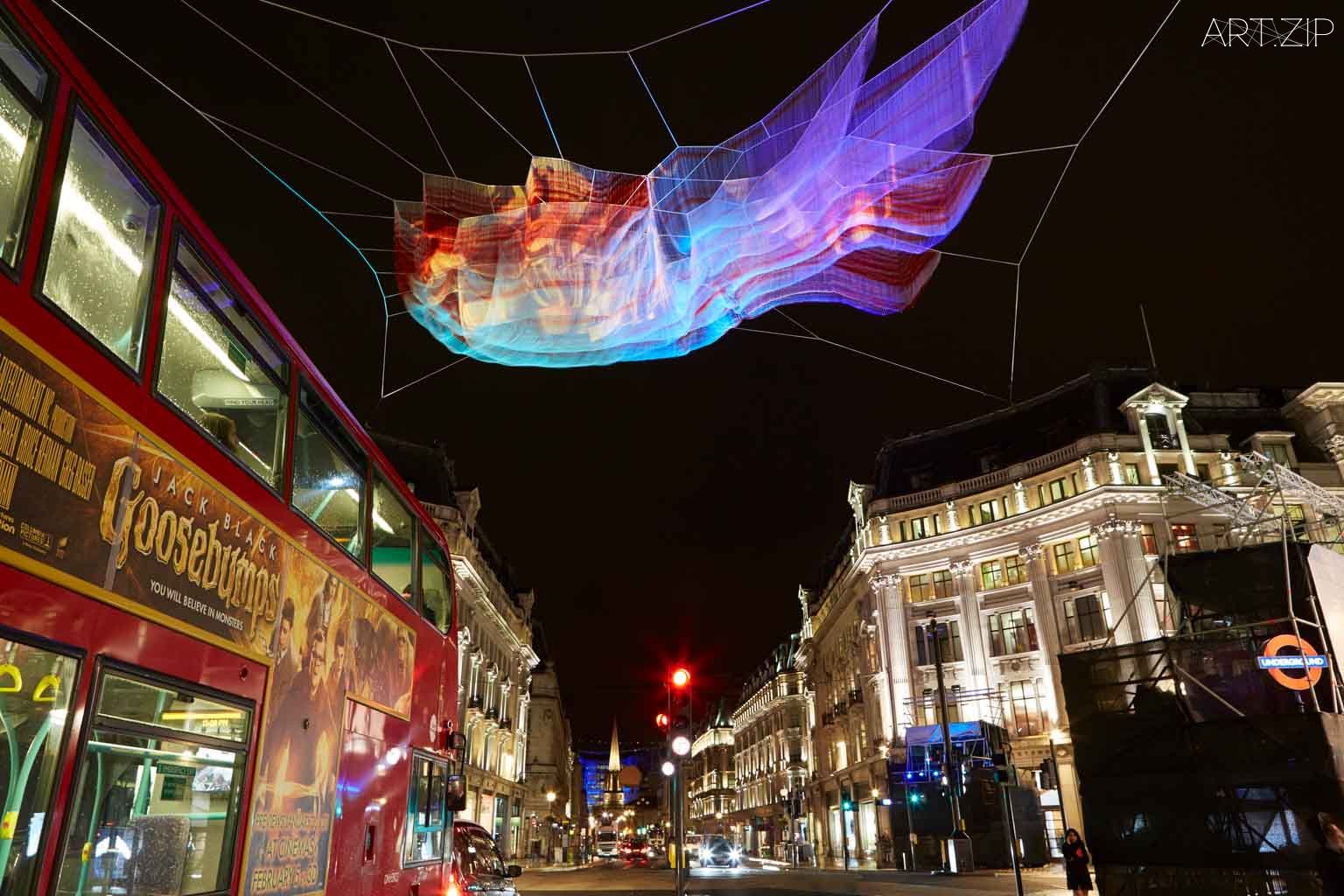
1.8 London, Janet Echelman, Lumiere London 2016, produced by Artichoke, supported by the Mayor of London. Image © Matthew Andrews
ART.ZIP: Indeed, a great aspect about Lumiere is that it brought people away from their regular route in order to engage with the city more physically in a more imaginative way.
HM: Yes, and more intimately in a way by discovering routes between places. If you travel by underground you don’t necessarily realise that the walk from Grosvenor Square to Regent’s Street takes literally 10 minutes and by taking that you realise the shops and architectures that you’ve never encountered. Part of the plan is to get people to move differently. Many of my team walked to the West end to King’s Cross took 25-30 minutes; that’s not the journey that anybody would normally take. They get to the underground because it is quick, but actually in certain circumstances they can’t. I suppose one of the aims of Lumiere was to encourage people to regard walking as a form of transport. They don’t actually need the bus or the tube, the walking route and that experience was as important as whether the tube is running on time.
ART.ZIP: 確實,燈光節最棒的一點在於讓人們偏離日常路線,從而能更加實實在在、充滿想象地去感知這個城市。
HM: 是呀,自己尋找路線還能讓人與城市之間的關係更親密呢。你要是天天乘地鐵,是不會意識到從格羅夫納廣場到攝政街走路只要十分鐘的。走路還能讓你發現你以前從未發現的店鋪與建築,所以燈光節的目的就是為了讓你探索城市。我的團隊花25到30分鐘從西區走到國王十字,一般人不會這麽走。一般人會為了快捷而選擇搭乘地鐵,但總有些特殊情況會讓他們搭不成。我做燈光節其中一個目的就是鼓勵人們將步行看作一種日常出行方式,不一定非要搭公交車或地鐵。而走哪條路會獲得怎樣的體驗與地鐵能否按時到達是同等重要的。
ART.ZIP: Walking is the cleanest form of transportation. Did you also consider the environmental issue, with the intention of invoking environmental consciousness in the individuals when you planned this project?
HM: It is very easy to criticise this kind of festival as waste of energy, but actually what we were trying now is to get the ordinary lighting switch off, so there is a balance for what we were adding. Some of the pieces pointed to ecological or environmental questions like the fountains at the Trafalgar Square roundabout, where I thought was beautiful but also made a very interesting point (Plastic Islands by Luzinterruptus). The piece up at King’s Cross is a campaign about providing sustainable lighting for people with no access to power. Through the programme you can educate and inform people, and change their view of light and its significance.
ART.ZIP: 的確,步行是最環保的交通方式了。您做策劃的時候是否也考慮到了對環境的影響,或希望能引起人們的環保意識?
HM: 其實很有可能會有人批評我們這樣的藝術節是在浪費能源,但事實上我們現在就是嘗試熄滅日常用燈以平衡我們添加的裝置所需的能耗。一些作品的確指向了環境與生態問題,比方說特拉法加廣場交叉路口的噴泉作品《Plastic Islands(塑料島)》,它們不但好看還很好地強調了這個問題。國王十字那邊的作品也呼籲了為無法用電的地區居民提供可持續光源。通過這個項目你可以告知民眾並改變他們對燈光及對光的意義的看法。
ART.ZIP: In terms of the physical encountering with the city and interpersonal relations, inside the festival, people were getting together.
HM: Yes, people lying in the middle of the road in Oxford Circus and it was the most amazing scene. They were so beautiful and that was the huge argument with the transport plan— you won’t close up services to important junctions for traffic; the buses have to be able to run east west. And eventually on Friday when I stepped out of the tube, I walked into the road and all these people were just lying on the road. I was almost in tears: that was the right decision then, good that we closed it. That experience was actually a unique one to people.
ART.ZIP: 就對城市的實體感受還有人與人之間的交往而言,燈光節讓人們實實在在地聚在一起了。
HM: 是呀,人們一齊躺在牛津街的馬路中央賞燈,那一幕太美好了。此前我在交通規劃局那邊做了很大的努力,他們說你不能在重要的交通路口封路,你得讓巴士能夠通行。但到了燈光節開幕那天,當我走出地鐵來到路上,看到大家躺在馬路上看燈的時候,我幾乎淚流滿面。封路是正確的決定,一切都是值得的。我想這對人們來說是一個非同尋常的體驗。
ART.ZIP: Yes, and you expressed before that in the age of digital technology, people were always doing online surfing, losing interpersonal and physical interaction. How would you comment on this now?
HM: I am a very analogue person; I am very old. There is new technology that I find it useful, but there is no passion. I don’t feel the newest pieces and I don’t do Facebook or Twitter or Instagram, although the office for the company does it. I can see how fascinating it is for the young people who have grown up with it, but for me, the real pleasure is about discovering that something is real. You have to put it as live experience, you have to be there rather than being mediated to you through big screen or television. I think in this world where we spend so much time behind the screen, receiving information, we feel that we have thousands of friends but actually never seeing them, or we don’t share space with other people because we are sitting in our bedroom never stopping working. For me, Artichoke serves as an alternative reality, in which for these brief moments the world has changed. You are invited and you can share the space with thousands of other people that you don’t know, who are not your friends, who are not on your Facebook list, but connections between you will be nonstop. It is actually about making real connection.
ART.ZIP: 確實是的,您之前也說過在數碼時代人們總因為上網而喪失人與人之間真實的交往與互動。您對這種現象怎麽看呢?
HM: 我是一個膠片時代的人,我很老派。我覺得新科技有用是有用,但就是對它們提不起興致。我沒法對最新的科技產生興趣,我不上臉書、推特或者別的社交平台,當然負責公司推廣運營的部門會使用它們。我能理解這些虛擬媒體對年輕人的吸引力,但我還是覺得真實的現實最讓我歡喜。你得去實實在在地感受、你必須在場,而非通過大屏幕或電視機去看。在當今世界,我們太習慣於把大量時間花在屏幕面前,通過它來接受信息,認為我們有萬千好友但實際上從未與他們相見;又或者我們從來不與他人共處同一個空間,因為我們習慣整日坐在自己的房間裡工作個沒完。對我而言,我們的宗旨就是為了創造一個與之相反的現實感,即使只有在那短短的幾個瞬間,世界發生了改變。在燈光節你會與成千上萬的其它人共處同一個空間,你不認識他們、他們也不在你的臉書朋友列表上,但在你們之間形成的是實實在在的關係。我們最希望做的,就是建立真實的聯繫。
Find Out More:
This article and interview refer to the Lumiere festivals which took place in Durham in 2015 and London in 2016.
Lumiere will return to Durham for the fifth time, commissioned by Durham County Council, 16-19 November 2017.
The second Lumiere London commissioned by the Mayor of London, will take place from 18-21 January 2018.
www.lumierefestival.com
www.visitlondon.com/lumiere

